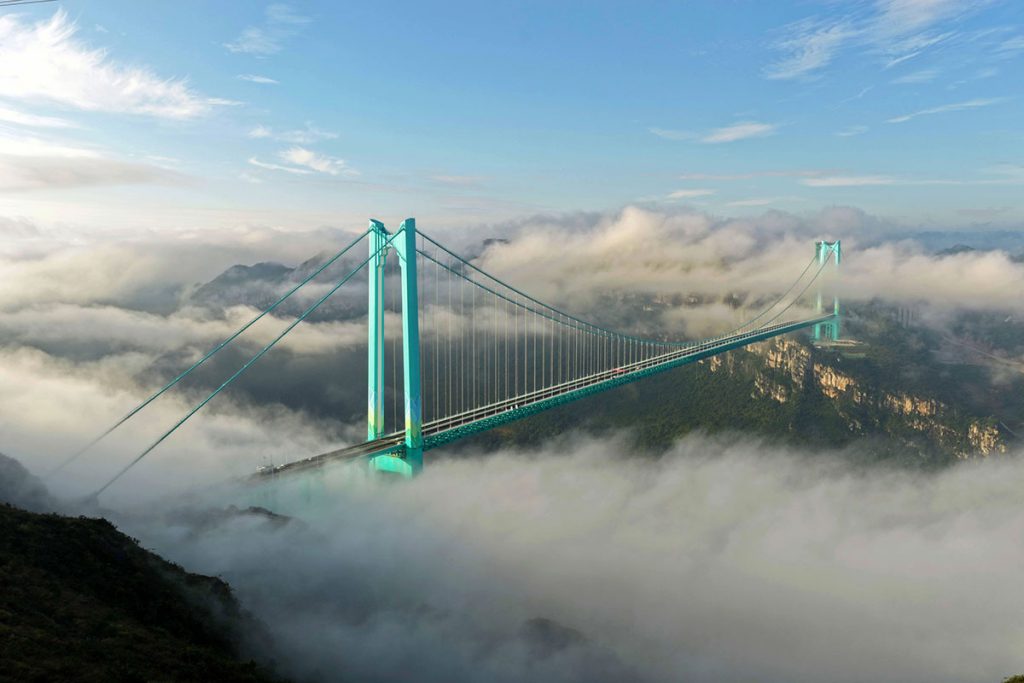China just built a bridge that doesn’t simply cross a canyon—it dominates it. And it has a coffee shop. At the top. Of the bridge tower. 625 meters above the river.
Let me say that again: You can now sip a latte while literally floating in the clouds, hundreds of meters higher than the Eiffel Tower, on a bridge that opened less than a month ago in one of China’s most remote provinces.
Welcome to Huajiang Canyon Bridge (花江峡谷大桥), and welcome to what might be the most audacious example of “because we can” engineering you’ll see in your lifetime.
If you’ve been following travel influencers like IShowSpeed discovering China’s hidden marvels, this is the next frontier. This isn’t the Great Wall that’s been photographed a billion times. This is a bridge that just opened on September 28, 2025, and most Westerners don’t even know it exists yet.
But they will. Because this isn’t just another bridge. It’s China’s boldest statement yet: “We don’t just build infrastructure—we build experiences.”
By the end of this guide, you’ll know exactly how to visit Huajiang Bridge China, what makes it completely different from anything you’ve seen, how to access those jaw-dropping facilities, and why this represents a completely new category of tourism in China. Let’s go.
What Makes the NEW Huajiang Bridge Different? (This Isn’t Your Average Bridge)
Wait, Which Bridge Are We Talking About?
Critical clarification first: If you’ve googled “highest bridge China” before, you probably saw information about the Beipanjiang Bridge (北盘江大桥), which held the world record from 2016 to 2025 at 565 meters high.
That’s NOT this bridge.
The NEW Huajiang Canyon Bridge (花江峡谷大桥) just superseded it in September 2025. It spans the same river system (Beipan River) but in a different location, stands at 625 meters high, and was specifically designed as a “bridge-tourism fusion” project from day one.
Think of it this way:
- Old Beipanjiang Bridge (2016): Pure transportation infrastructure that tourists can view from platforms nearby
- NEW Huajiang Canyon Bridge (2025): Transportation infrastructure that’s ALSO a purpose-built tourism destination with integrated adventure facilities
This is the bridge everyone will be talking about in 2026.
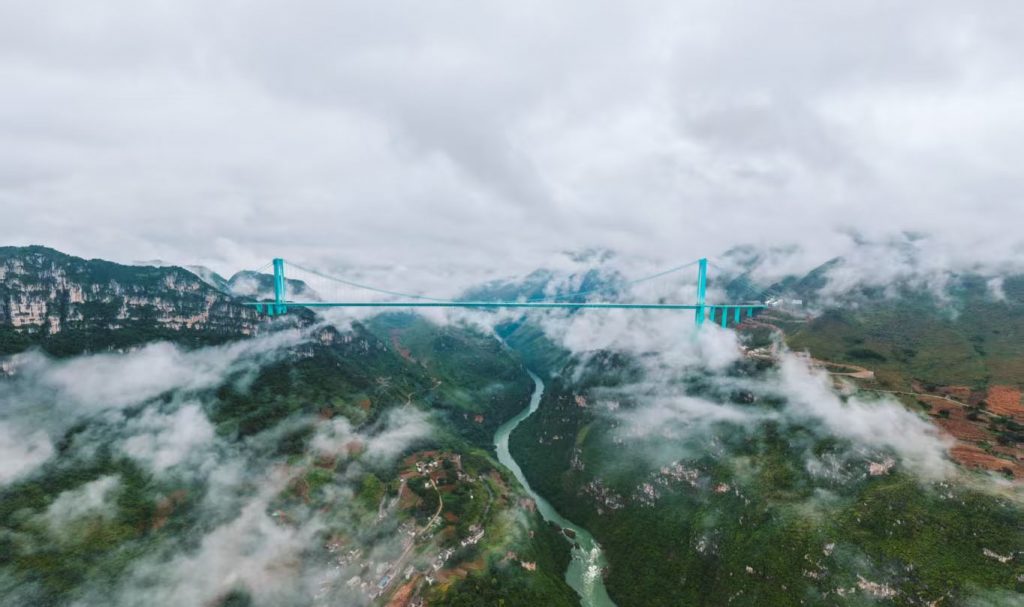
The Mind-Blowing Stats
Total length: 2,890 meters (almost 2 miles)
Main span: 1,420 meters (world’s longest single-span suspension bridge in mountainous terrain)
Height above water: 625 meters (2,051 feet)
Bridge type: Steel truss suspension bridge
Construction time: 3 years 8 months (2022-2025)
Total investment: 28.7 billion RMB (approximately $4 billion USD)
To put that height in perspective:
- 625 meters is:
- Nearly twice the Eiffel Tower (330m)
- Taller than One World Trade Center’s roof (541m)
- About the same as the 200th floor of a skyscraper
- High enough that low-hanging clouds often drift below the bridge deck
The “Bridge-Tourism Fusion” Revolution
Here’s what makes Huajiang Canyon Bridge genuinely revolutionary: It was conceived from the start as a “bridge-tourism fusion 3.0” demonstration project, integrating “bridge observation + extreme sports experiences + tourism services” into a single comprehensive destination.
What this means in practice:
1. Sky-High Coffee Shop
There’s a coffee shop being built at the top of the bridge tower—one of the pylons that holds up the suspension cables. To get there, they’ve constructed a dedicated elevator tower adjacent to the bridge pylon. This will likely become one of the highest public coffee shops on Earth.
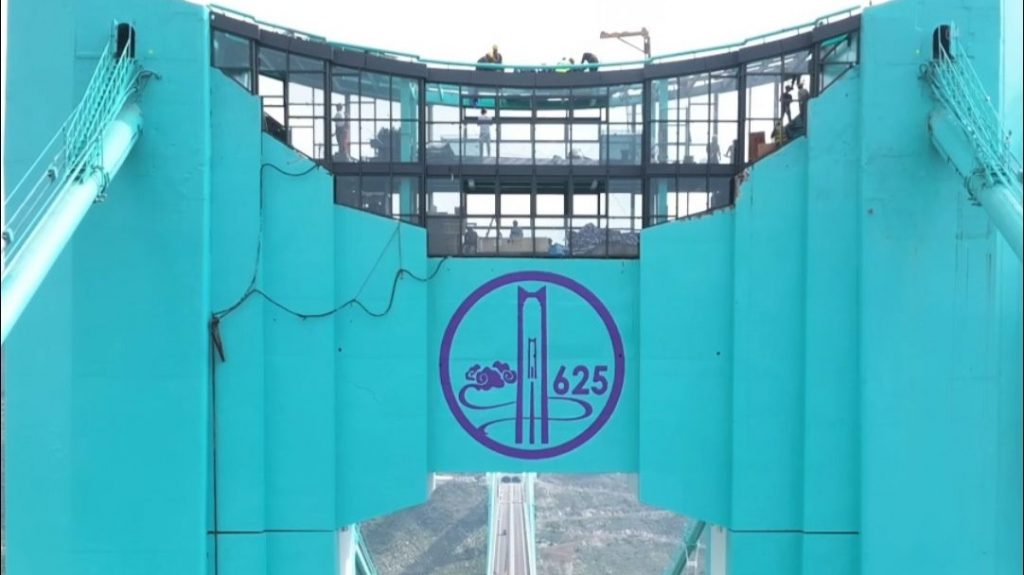
2. Extreme Sports Center
Plans include developing an extreme sports center at the canyon bottom, which will likely feature:
- World’s highest commercial bungee jump (exact specifications still being finalized as of October 2025)
- Potential for BASE jumping or specialized ziplines
- Rock climbing routes on the canyon walls
- Whitewater activities on the Beipan River
Note: As of October 2025, some facilities are still under development. The bridge itself is open, but the full roster of adventure activities is rolling out through late 2025 and early 2026.
3. Observation Platforms with Actual Design
Unlike older Chinese bridge viewing platforms (which were often afterthoughts), Huajiang’s observation areas were designed by architects as integral parts of the experience. Expect:
- Glass walkways extending out over the void
- Multi-level viewing decks at different heights
- Professional photography spots with optimal angles
- Interpretive displays explaining the engineering (with English translations—a first for many Guizhou bridges)
4. Modern Amenities
We’re talking about:
- Clean, modern restrooms (Western and squat options)
- Proper restaurants, not just instant noodle stands
- Gift shops with actual design (not just cheap trinkets)
- Free WiFi in the visitor center
- English signage throughout (still being implemented as of October 2025)
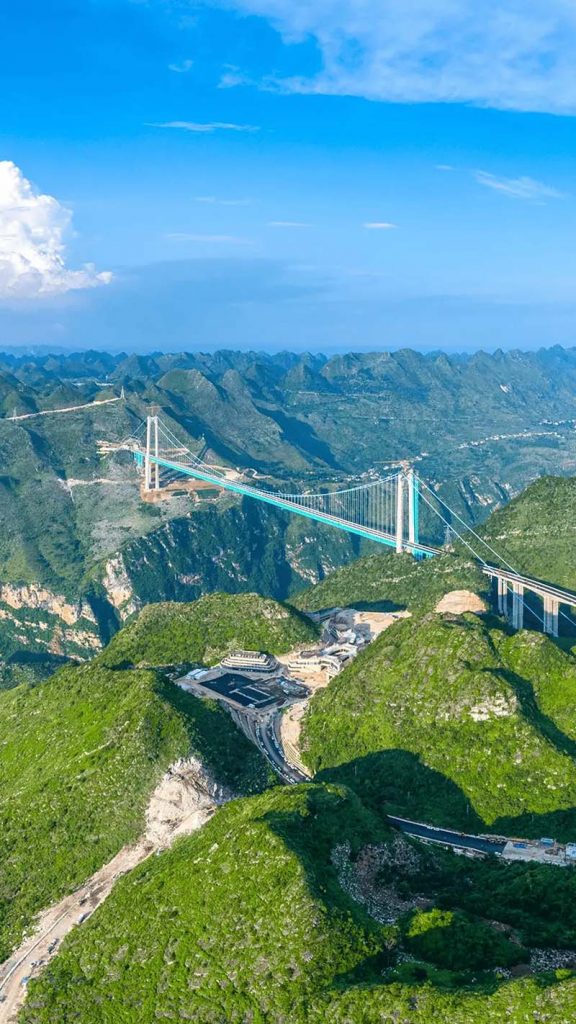
The “Cultural Shock” Dimension: China’s Infrastructure Philosophy
For Western visitors, this bridge represents a fundamental philosophical difference in how China approaches infrastructure.
In most countries, a $4 billion bridge spanning one of Earth’s most challenging terrains would be considered complete when vehicles can cross it safely. Mission accomplished.
In China—specifically in Guizhou Province in 2025—that same bridge is considered half-finished unless it can also:
- Attract tourists from around the world
- Create jobs in rural communities
- Generate revenue to help fund itself
- Become an iconic symbol that puts the region on the map
- Offer experiences that can’t be found anywhere else
The fact that China is spending significant additional money to install a coffee shop on top of a bridge tower—complete with a dedicated elevator system—tells you everything about this mindset. It’s audacious. It’s extra. And it’s absolutely fascinating.
This is infrastructure as performance art.
The Complete 2025 Visitor’s Guide to Huajiang Bridge China
Precise Location & Geography
Huajiang Canyon Bridge is located on the border between Guanling County (关岭县, Anshun City) and Zhenfeng County (贞丰县, Qianxinan Prefecture) in Guizhou Province, spanning the Beipan River at the Huajiang section.
GPS Coordinates: 25.7294° N, 105.4867° E
Chinese Address for Navigation: 贵州省安顺市关岭县花江大峡谷大桥
Part of: Liuzhi to Anlong Expressway (六安高速)
Distances from major cities:
- Guiyang (Guizhou’s capital): ~200km, 2.5-3 hours drive
- Anshun (nearest major city): ~90km, 1.5 hours drive
- Huangguoshu Waterfall: ~70km, 1-1.5 hours drive
- Kunming, Yunnan: ~450km, 5-6 hours drive
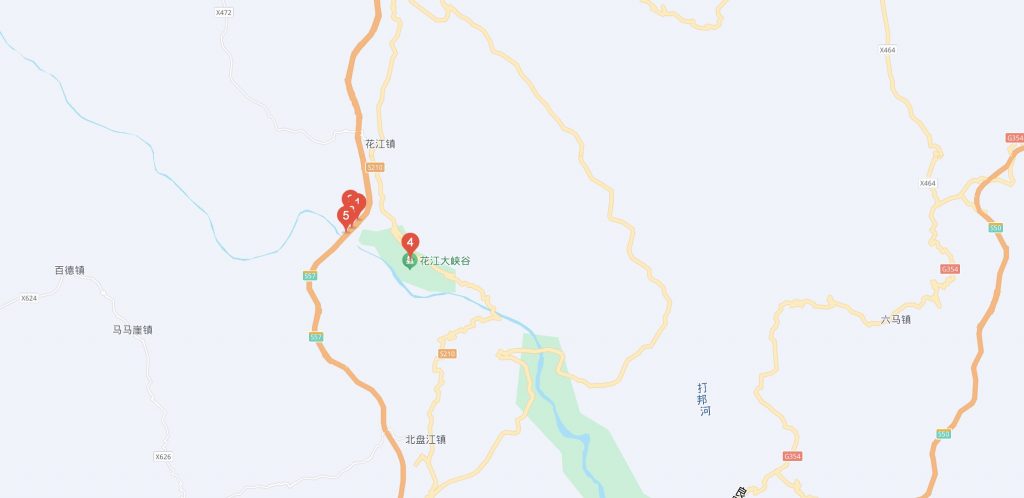
The Setting:
The bridge crosses the Huajiang section of Beipan River gorge, known locally as “Earth’s Crack” (地球裂缝) due to its extreme depth and near-vertical karst limestone walls. The gorge is part of the larger Huajiang Canyon scenic area, which is also being developed as a national-level tourist destination.
How to Get There: Your Complete Transportation Guide
Option 1: High-Speed Train + Local Transfer (Recommended for Most Travelers)
This is now the easiest and most reliable method for independent travelers.
Step 1: Take High-Speed Train to Guanling Station
- From Guiyang North Station (贵阳北站):
- Train line: Shanghai-Kunming High-Speed Railway (沪昆高铁)
- Frequency: Every 30-60 minutes throughout the day
- Journey time: 35-40 minutes
- Cost: Second class ~60 RMB ($8), First class ~95 RMB ($13)
- From Kunming South Station (昆明南站):
- Same train line, opposite direction
- Journey time: 2.5-3 hours
- Cost: Second class ~180 RMB ($25)
Step 2: Guanling Station to Huajiang Bridge
- Distance: Approximately 45km, 45 minutes-1 hour
- Options:
- Taxi/Didi: 120-180 RMB ($17-25) one-way. Most drivers will wait for you for an hourly rate (~100 RMB/hour)
- Rideshare: Use Didi app (Chinese Uber). International credit cards sometimes work
- Tour bus: As of October 2025, tourist shuttles are being organized from Guanling Station. Check at the station information desk.
Booking high-speed train tickets:
- Trip.com (English interface, accepts international cards)
- 12306.cn (official Chinese railway site—Chinese only but cheapest)
- Your hotel can usually book for you
Pro tip: Book train tickets at least 2-3 days in advance during Chinese holidays (October Golden Week, Chinese New Year). Otherwise, same-day tickets are usually available.
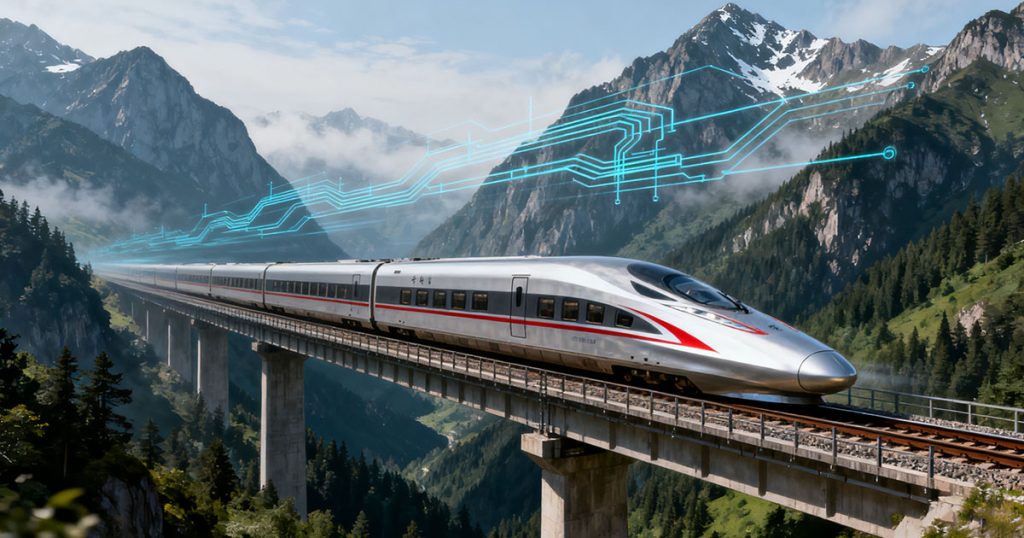
Option 2: Self-Drive (Most Flexible)
From Guiyang:
- Take Shanghai-Kunming Expressway (G60) westbound toward Anshun/Kunming
- Exit at Guanling (关岭) exit
- Follow signs to Liuzhi-Anlong Expressway (六安高速) southbound
- Bridge will be clearly marked
- Total drive: 200km, approximately 2.5-3 hours
- Tolls: ~100 RMB ($14)
- Parking: Large parking area at visitor center, 20-30 RMB ($3-4)
From Anshun:
- Follow G60 east, then same as above
- Distance: ~90km, 1.5 hours
Navigation apps:
- Baidu Maps (百度地图): Has English interface, most reliable
- Amap/Gaode (高德地图): More accurate but Chinese only
- Search term: “花江峡谷大桥” or “花江大桥”
IMPORTANT: Google Maps is blocked in China and notoriously inaccurate even with VPN. Download Chinese navigation apps before you go.
Car rental reality check:
- International licenses not recognized in China
- Chinese temporary license is bureaucratically complex
- Best option: Rent a car with driver (500-800 RMB/day, $70-110)
Option 3: Organized Day Tour (Easiest, Zero Stress)
As of October 2025, tour companies in Guiyang and Anshun are rapidly developing Huajiang Bridge day trips. These typically include:
Standard package:
- Hotel pickup/dropoff
- Transportation
- English-speaking guide (quality varies)
- Entrance tickets
- Lunch at a local restaurant
- 3-4 hours at the bridge
Cost: 400-700 RMB per person ($55-95) depending on group size
Where to book:
- Trip.com / Ctrip (English, international-friendly)
- Klook (expanding China offerings)
- Your hotel concierge
- Local hostels often organize group trips
Combined tours:
Many operators are now offering 2-day packages combining Huajiang Bridge + Huangguoshu Waterfall + minority villages. These are excellent value if you have limited time in Guizhou.
Option 4: Public Bus (Budget Option, Complex)
Doable but not recommended unless you’re an experienced China traveler with good Chinese language skills or translation apps.
- Guiyang → Guanling: Long-distance bus from Guiyang Tourist Bus Station (3-4 hours, ~60 RMB)
- Guanling → Bridge: Local minibuses or hired van (infrequent, irregular schedules)
Reality: The public bus network to the bridge is still developing. By mid-2026 this will likely improve, but as of October 2025 it’s frustrating for non-Chinese speakers.
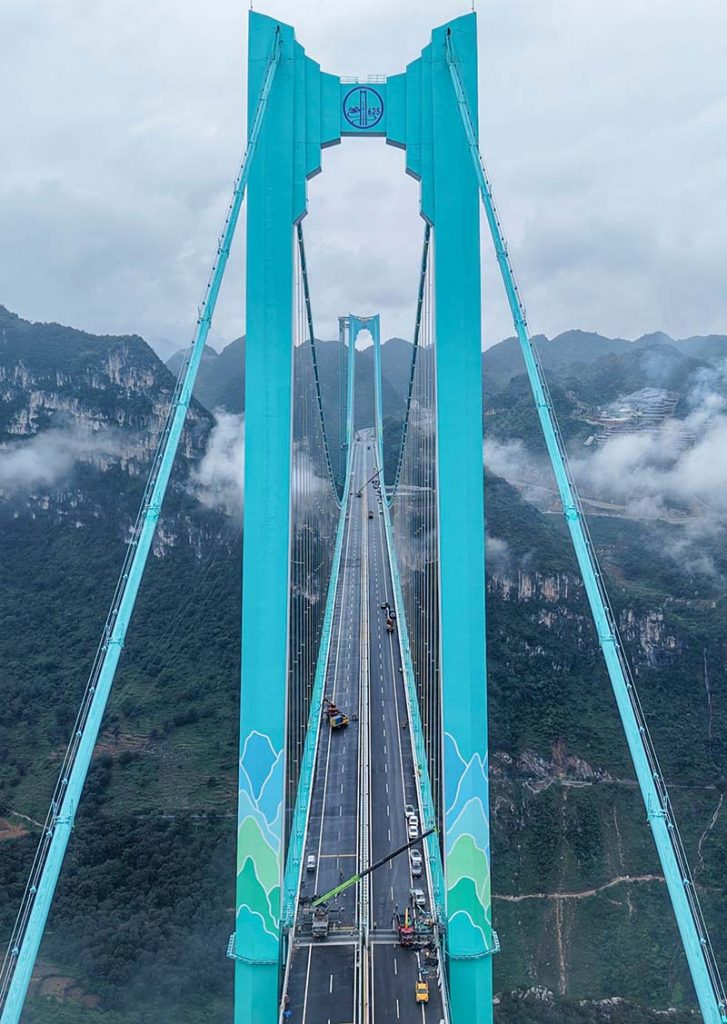
Tickets, Costs & Booking (October 2025 Pricing)
IMPORTANT: As the bridge just opened, pricing and booking systems are still being finalized. These are the best current estimates:
Entrance to Bridge Scenic Area:
- Cost: 80-120 RMB per person ($11-17)
- Includes: Access to viewing platforms, basic glass walkways, visitor center
- Children/Seniors: 50% discount (verify ID requirements)
Sky-High Coffee Shop (Tower Elevator):
- Estimated cost: 150-200 RMB ($21-28)
- Includes: Elevator ride to tower top + one beverage
- Note: As of October 2025, still in soft opening phase
Extreme Sports Activities:
- Bungee jumping: Not yet operational (expected late 2025/early 2026)
- Estimated cost when opens: 3,000-5,000 RMB ($415-690)
- Other activities: TBA
Photography/Videography:
- Personal phone/camera: Included in entrance ticket
- Professional equipment: May require additional permit
- Drones: PROHIBITED (see important note below)
Combination Tickets:
The scenic area is developing packages that combine:
- Bridge viewing + local village tour + waterfall viewing
- Estimated: 200-300 RMB ($28-42)
Where to buy tickets:
- On-site: Visitor center ticket office (cash or WeChat Pay/Alipay)
- Online: Official WeChat mini-program (Chinese only currently)
- Tour operators: Usually include tickets in package price
When to Visit: Best Times & What to Expect
Optimal Months: September-November & March-May
Why these periods:
- Clear weather: Minimal rain, good visibility
- Comfortable temperatures: 15-25°C (59-77°F)
- Stunning visuals: Autumn colors or spring flowers in the gorge
Season-by-season breakdown:
Spring (March-May):
- ✅ Fresh green landscape, blooming flowers
- ✅ Good visibility most days
- ⚠️ Can be rainy in late May
- Crowds: Moderate
Summer (June-August):
- ❌ Rainy season—high chance of fog/rain obscuring views
- ❌ Hot and humid
- ✅ Dramatic storm clouds can create epic photos
- Crowds: Heavy during school holidays
Autumn (September-November):
- ✅✅ BEST SEASON—clear skies, comfortable temps
- ✅✅ Stunning autumn foliage in the canyon
- ✅ Crystal-clear visibility
- Crowds: Peak in October (Golden Week), moderate otherwise
Winter (December-February):
- ⚠️ Cold (0-10°C / 32-50°F), occasional snow
- ✅ Fewer crowds, lower prices
- ✅ Unique snowy landscape when it snows
- ❌ Some facilities may have reduced hours
Best time of day:
- Early morning (7-9 AM): Mist in the gorge, fewer crowds, magical atmosphere
- Late afternoon (4-6 PM): Golden hour lighting, warm glow on bridge structure
- Midday: Harshest light but best for seeing the full depth of the canyon
Weather reality check:
Mountain weather is unpredictable. Even in “dry” months, sudden fog can roll in. Build flexibility into your schedule if possible—staying in Anshun or Guanling overnight lets you try again the next morning if weather doesn’t cooperate.
How Long to Spend at Huajiang Bridge
Minimum visit: 2-3 hours
- View the bridge from main platforms
- Walk the glass walkway
- Visit center exhibits
Recommended visit: 4-5 hours
- Above + coffee shop experience
- Multiple viewing angles
- Leisurely photography time
- Lunch at on-site restaurant
Full experience: 6-8 hours
- All above + nearby attractions
- Possible hike into upper canyon
- Visit to local Bouyei village
- Wait for golden hour lighting
With extreme sports (when available): Full day
- Bungee jump requires pre-registration, safety briefing, recovery time
Beyond the Bridge: What Else to Experience
The Canyon Floor & Extreme Sports Center
Plans are underway to develop a comprehensive extreme sports center at the canyon bottom. While still under construction as of October 2025, the vision includes:
Proposed activities:
- World-record bungee jump from the bridge (exact height TBA—potentially 600+ meters)
- Canyon ziplines
- Via ferrata (iron path) climbing routes on canyon walls
- Whitewater rafting on the Beipan River
- Rock climbing areas
Timeline: Expected phased openings through 2026
Access: A combination of stairs and potential cable car/funicular system is being developed to transport visitors to the canyon floor (625 vertical meters down!).
Cultural Experiences: Bouyei & Miao Villages
The area around Huajiang Bridge is home to Bouyei (布依族) and Miao (苗族) ethnic minorities. Several villages within 20-30 minutes of the bridge offer authentic cultural experiences.
Recommended villages:
1. Huajiang Town (花江镇)
- Traditional market town
- Famous for Huajiang dog meat (controversial dish—if you’re not comfortable, stick to other local foods)
- Bouyei architecture and cultural center
2. Nearby Traditional Villages
- Authentic wooden stilt houses
- Hand-woven textiles (batik, embroidery)
- Traditional festivals (if your timing aligns—ask locals about upcoming dates)
What to do:
- Homestay experiences (can be arranged through tour operators)
- Learn traditional crafts
- Try authentic minority cuisine
- Participate in festivals if timing is right
Cultural sensitivity:
- Always ask before photographing people
- Dress modestly when visiting villages
- Purchase handicrafts directly from artisans to support communities
- Learn basic greetings in Chinese
Combining Attractions: The Ultimate Guizhou Itinerary
Huajiang Bridge pairs perfectly with:
1. Huangguoshu Waterfall (黄果树瀑布)
- China’s most famous waterfall
- Only 70km from Huajiang Bridge
- Can be done as a combined day trip from Anshun
2. Zhijin Cave (织金洞)
- Massive karst cave system
- About 120km from the bridge
- Stunning underground formations
3. Anshun Old Town (安顺古城)
- Historic city with traditional architecture
- Batik cultural center
- Good base for exploring the region
Sample 3-day itinerary:
Day 1: Arrive Guiyang → Anshun
- Morning: Arrive in Guiyang
- Afternoon: Transfer to Anshun (1.5 hours)
- Evening: Explore Anshun Old Town
- Overnight: Anshun
Day 2: Huajiang Bridge
- Early departure for Huajiang Bridge
- Full day at bridge (morning light + golden hour)
- Optional: Visit nearby village
- Overnight: Anshun or Guanling
Day 3: Huangguoshu Waterfall → Depart
- Morning: Huangguoshu Waterfall
- Afternoon: Return to Guiyang for evening departure
The Reality Check: What Travel Guides Won’t Tell You
1. It’s BRAND NEW—Expect Growing Pains
The bridge opened September 28, 2025. As of October 2025:
What’s working well:
- The bridge itself is complete and safe
- Basic viewing platforms are operational
- High-speed train access is excellent
- Main facilities are functional
What’s still developing:
- Some signage is still Chinese-only
- Not all planned activities are open yet
- Staff are still learning procedures
- English-language materials are limited
What this means for you:
- Be flexible and patient
- Download translation apps
- Facilities will improve rapidly over the next 6-12 months
- You’re genuinely among the first Western tourists here
2. The Language Barrier Is Real
Unlike Beijing or Shanghai tourist sites, English proficiency here is very limited. Even at the ticket office and visitor center, staff may speak only Chinese.
Essential survival strategies:
Download before you go:
- Google Translate (Chinese offline package)
- Pleco (best Chinese dictionary app)
- Photos of your hotel address in Chinese
- Screenshot the bridge name in Chinese: 花江峡谷大桥
Learn survival phrases:
- “你好” (nǐ hǎo) = Hello
- “谢谢” (xiè xie) = Thank you
- “多少钱?” (duō shǎo qián) = How much?
- “厕所在哪里?” (cè suǒ zài nǎ lǐ) = Where is the toilet?
- “我不吃辣” (wǒ bù chī là) = I don’t eat spicy food (ESSENTIAL in Guizhou!)
3. Payment Methods: The Cash vs Cashless Dilemma
China is essentially cashless—but not in the Western way.
What works everywhere:
- WeChat Pay (微信支付)
- Alipay (支付宝)
What barely works:
- International credit cards (Visa/Mastercard)
- Cash is accepted but less convenient
The foreigner problem:
Setting up WeChat Pay or Alipay traditionally required a Chinese bank account. Recently, both apps have introduced “foreigner-friendly” versions that link to international credit cards, but:
- Setup can be finicky
- Not all merchants accept the international version
- Transaction limits may apply
Your best strategy:
- Before China: Try to set up WeChat Pay’s international tourist version
- Backup: Bring plenty of cash RMB (ATMs at Guanling Station and in Anshun)
- Emergency: Some larger establishments accept Alipay with international cards
For Huajiang Bridge specifically:
As of October 2025, the ticket office accepts both cash and Chinese mobile payment. Credit card terminals are being installed but may not be operational yet.
4. The Drone Situation: DO NOT BRING YOUR DRONE
This is critical: Flying drones in China is highly regulated and penalties are severe.
The laws:
- All drones must be registered with Chinese authorities
- Many areas (including near bridges, infrastructure, and military sites) are no-fly zones
- Foreign tourists have been detained and had equipment confiscated
At Huajiang Bridge:
- This is a major infrastructure project—definitely a restricted area
- Security personnel actively watch for drones
- You WILL be stopped and possibly face legal consequences
Alternative:
Professional photographers at the scenic area offer drone footage packages. Let them handle the legal complications.
5. Toilets & Hygiene Standards
Let’s be honest about bathroom facilities in rural China.
At Huajiang Bridge visitor center (NEW facility):
- Modern, clean restrooms
- Both Western-style and squat toilets
- Toilet paper usually provided
- Hand soap and running water
- Cleaned regularly
This is MUCH better than older Chinese tourist sites!
However:
- Some viewing platform areas may have more basic facilities
- Always carry your own tissues/toilet paper as backup
- Hand sanitizer is your friend
- If you absolutely cannot use squat toilets, head back to the main visitor center
6. The Weather Factor: Mother Nature is Boss
625 meters in the air means weather is extreme and unpredictable.
Real talk:
- Fog can completely obscure the bridge within minutes
- Wind can be strong enough to feel unsafe on exposed platforms
- Rain turns glass walkways slippery
- Temperature can be 10°C colder than ground level
What happens if weather is bad:
- Some facilities may close for safety
- You might see nothing but white mist
- Photos will be disappointing
- Bungee jumping (when operational) will be canceled
Mitigating the risk:
- Check weather forecasts for both Guanling and specific mountain weather
- Visit during dry season (September-November)
- Have a flexible schedule if possible
- Some travelers report that fog often burns off by 10-11 AM—consider waiting
The silver lining:
Some of the most dramatic photos happen in partial fog, with the bridge emerging from mist. It’s unpredictable but can be magical.
Photography Guide: Capturing Huajiang Bridge China
Best Shooting Locations
Position 1: Main Viewing Platform (Classic Angle)
- Head-on view of the full bridge span
- Best for showing the scale and drama
- Lens: Wide-angle (16-24mm) or ultra-wide (12-16mm)
- Best time: Late afternoon golden hour
- Pro tip: Use a person in the foreground for scale
Position 2: Glass Walkway (Vertiginous Shots)
- Looking straight down 625 meters
- Instagram-gold with your feet on the glass
- Lens: Wide-angle with the glass texture visible
- Best time: Morning when glass is cleanest
- Pro tip: Clean your lens frequently—the glass walkway attracts fingerprints
Position 3: Elevated Side Angle
- Some platforms offer a 3/4 view showing bridge + canyon
- Best for conveying the dramatic landscape
- Lens: Standard zoom (24-70mm) or telephoto (70-200mm)
- Best time: Early morning with mist in the canyon
Position 4: Canyon Floor (When Accessible)
- Looking UP at the bridge from below
- Creates mind-bending perspective
- Lens: Wide-angle to capture the full height
- Best time: Midday when the sun is overhead
Settings & Technical Tips
For the bridge structure:
- Aperture: f/8-f/11 for maximum sharpness throughout
- ISO: Keep as low as possible (100-400) for clean details
- Shutter speed: 1/250s or faster if windy (to freeze movement)
For the misty canyon:
- Aperture: f/5.6-f/8
- ISO: 400-800 depending on light
- Shutter speed: 1/125s-1/500s
- Tip: Expose for the bridge, let the mist be slightly overexposed for ethereal effect
For dramatic skies:
- Use a polarizing filter: Deepens blue skies, reduces haze
- Graduated ND filter: Balances bright sky with darker canyon
- HDR bracketing: Take 3-5 exposures and blend in post-processing
Golden hour magic:
- Arrive 45 minutes before sunset
- Scout your position early (crowds gather quickly)
- Shoot in RAW for maximum editing flexibility
- The bridge cables glow beautifully in warm light
Night photography (if permitted):
- Tripod essential
- Long exposures (5-30 seconds) to capture light trails if traffic passes
- ISO 800-3200 depending on available light
- If there’s a light show, shoot multiple exposures and stack them
Instagram-Worthy Compositions
1. The Perspective Shot
- Stand at one end of the glass walkway
- Shoot down the length showing the transparent floor + abyss below
- Wear colorful shoes for pop of color
2. The Scale Shot
- Position a person on the viewing platform
- Shoot from distance to show how tiny humans are compared to the structure
- Works best with telephoto lens (70-200mm)
3. The Emergence Shot
- Partial fog with bridge towers emerging from clouds
- Creates mythical, otherworldly feeling
- Requires luck with weather
4. The Reflection Shot
- After rain, puddles on viewing platforms reflect the bridge
- Creates stunning symmetry
- Low angle, shoot with phone or camera close to the ground
Mobile Photography Tips
You don’t need expensive gear to capture this place:
- Use portrait mode to blur background and emphasize the drop
- Panorama mode works great for the full bridge span
- Night mode on newer phones captures surprisingly good low-light shots
- Burst mode for capturing people on the glass walkway
- Clean your lens constantly—humidity and fingerprints are your enemy
Video Content Ideas
For TikTok/Instagram Reels/YouTube Shorts:
- The Walk-On
- Film yourself walking onto the glass walkway
- Camera follows your feet
- Reveal the drop below
- Caption: “POV: Walking on glass 625m above China’s deepest canyon”
- The Pan Reveal
- Start on your face (showing nervousness/excitement)
- Slowly pan to reveal the bridge and canyon
- Soundtrack: Epic/dramatic music
- The Comparison
- Film the bridge
- Cut to graphics showing it’s taller than Eiffel Tower, etc.
- Hook: “This Chinese bridge is taller than…”
- The Coffee Moment
- Film yourself ordering/drinking coffee at the sky-high café
- Cut to shots of the view from the window
- Caption: “Having coffee at 625 meters is different”
Frequently Asked Questions (FAQ)
Is this the same as the Beipanjiang Bridge I saw online?
No. This is a source of major confusion.
Beipanjiang Bridge opened in 2016, stands at 565 meters high, and was the world’s highest bridge until September 2025. It’s still there and still impressive, but it’s a pure transportation bridge with viewing platforms nearby.
Huajiang Canyon Bridge opened in September 2025, stands at 625 meters high (60 meters taller), and was designed from day one as an integrated bridge-tourism destination with coffee shops, extreme sports facilities, and premium viewing experiences built into the structure itself.
They cross the same river system but are different bridges. Huajiang Canyon Bridge is the NEW world record holder and the one with all the tourist facilities.
How do I book the bungee jump as a foreigner?
As of October 2025, the bungee jumping facility is still in final testing and not yet open to the public. When it does open (expected late 2025 or early 2026):
Booking process will likely involve:
- WeChat Mini-Program: Official booking system (Chinese language)
- Phone booking: Call the scenic area (+86 number, Chinese language required)
- Through tour operators: Easiest for foreigners—your guide handles it
- On-site: Possible but risky—slots may be full
Requirements (anticipated):
- Age: 18-60 years old
- Weight: 45-120kg (99-265 lbs)
- Health declaration form
- Passport for registration
- Sign extensive liability waivers
- Pre-jump health check
Cost estimate: 3,000-5,000 RMB ($415-690)
Your best bet: Have your hotel concierge or tour guide help with booking. They can navigate the Chinese-language systems and ensure you have a confirmed slot.
What are the operating hours for facilities?
As of October 2025:
Bridge viewing platforms:
- Daily: 8:00 AM – 6:00 PM (may extend to 7:00 PM in summer)
- Last entry: 5:00 PM
Sky-high coffee shop (when fully operational):
- Expected hours: 9:00 AM – 6:00 PM
- May have weather-dependent closures
Visitor center:
- Daily: 8:00 AM – 6:30 PM
Note: These hours may change as operations stabilize. Always verify current hours before visiting, especially if you’re arriving early or late.
Weather closures:
High winds, heavy fog, or severe weather can force temporary closures of exposed platforms and the glass walkway for safety. There are no refunds for weather-related closures, so check forecasts carefully.
Is Huajiang Bridge child-friendly?
It depends on the child.
Suitable for:
- Children 6+ who are comfortable with heights
- Kids interested in engineering and big structures
- Families who want an educational experience
Challenging for:
- Very young children (facilities require walking, standing)
- Kids with height phobias (this will be terrifying)
- Children who need constant entertainment (it’s primarily viewing/photography)
Practical considerations:
- Strollers are difficult on viewing platforms
- Changing facilities are available in main visitor center
- No specific children’s activities (as of October 2025)
- Children under 12 must be supervised at all times, especially on glass walkway
Safety note: The railings and barriers are built to international standards, but parents need to actively supervise children near edges and on glass walkways.
Age restrictions:
- Bungee jumping: Minimum age 18 (when operational)
- Coffee shop tower: No official age limit but parental discretion advised
Can I visit if I’m afraid of heights?
Honest answer: It will be very uncomfortable.
This isn’t a mild height experience. 625 meters is genuinely extreme, and the glass walkway is designed to emphasize the drop. Many people with mild height discomfort report being overwhelmed.
That said:
- The main viewing platforms have solid railings
- You can stay back from edges
- The visitor center and some viewing areas don’t require going onto exposed platforms
- Seeing the bridge structure itself is impressive even from safer vantage points
If you have genuine acrophobia (clinical fear of heights):
- This might not be the attraction for you
- Consider visiting just the visitor center and exhibits
- The engineering displays and cultural exhibits tell the story without requiring you to go on high platforms
No judgment either way. Know your limits. This bridge respects no one’s comfort zone.
What should I wear?
Essential:
- Comfortable walking shoes: You’ll be on your feet 2-4 hours. Platforms have stairs and uneven surfaces.
- Layers: Temperature varies significantly between ground level and bridge level
- Light jacket or windbreaker: Wind at 625m is real and often cold
Recommended:
- Sunglasses (high altitude = intense sun)
- Hat with secure strap (it’s windy—baseball caps blow off)
- Sunscreen (SPF 30+)
For glass walkway:
- Closed-toe shoes required
- They may provide disposable shoe covers
For bungee jumping (when operational):
- Athletic wear
- Closed-toe athletic shoes
- Nothing loose that can tangle (remove jewelry, scarves, loose accessories)
- Secure your hair
Weather-dependent:
- Rain jacket if forecast is uncertain
- Warm layer in winter months (December-February)
Cultural note: This is a rural area with traditional values. While tourists have more leeway, avoid:
- Very revealing clothing (short shorts, crop tops)
- Clothing with political messages
- Overly casual attire if you’re planning to visit local villages afterward
How much should I budget for a full day visit?
Budget breakdown (per person, October 2025 estimates):
Transportation:
- High-speed train: Guiyang-Guanling return: 120 RMB ($17)
- Local taxi/Didi: Guanling Station-Bridge return: 300 RMB ($42)
- OR Organized tour: 400-700 RMB ($55-95)
Entrance & Activities:
- Scenic area ticket: 80-120 RMB ($11-17)
- Coffee shop/tower elevator: 150-200 RMB ($21-28)
- Photos/souvenirs: 50-100 RMB ($7-14)
Food:
- Lunch at on-site restaurant: 60-100 RMB ($8-14)
- Snacks/drinks: 30-50 RMB ($4-7)
Total for independent traveler: 790-1,190 RMB ($110-165)
Total with organized tour: 650-1,050 RMB ($90-145)
Budget tip: Bring your own snacks and water to save money. Prices at tourist sites are always inflated.
Future costs (when available):
- Bungee jumping: +3,000-5,000 RMB ($415-690)
- Other extreme sports: TBA
Is there mobile phone signal and WiFi?
Mobile signal:
- Generally good coverage (4G/5G) at the bridge itself from China Mobile, China Unicom, and China Telecom
- Can be spotty in the deeper parts of the canyon
WiFi:
- Free WiFi available in the main visitor center
- Password usually posted or available at information desk
- Coffee shop (when open) will have WiFi for customers
- Viewing platforms: No WiFi
Internet access reality:
- Google, Facebook, Instagram, WhatsApp, etc. are blocked in China
- Set up a VPN before arriving in China (ExpressVPN, Astrill, VyprVPN)
- Even with VPN, connection can be slow
Pro tips:
- Download offline maps before you go
- Download WeChat (works in China, useful for asking for help)
- Save important information (hotel address, emergency contacts) offline
What if I need medical help?
On-site:
- First aid station at the visitor center
- Staff trained in basic emergency response
- AED (automated external defibrillator) available
Nearest hospital:
- Guanling County Hospital: ~45km away, 45 minutes drive
- Basic emergency care, limited English
Better hospitals:
- Anshun City hospitals: 90km away, 1.5 hours
- Guiyang major hospitals: 200km away, 2.5-3 hours
Emergency numbers:
- Ambulance: 120
- Police: 110
- Fire: 119
Travel insurance:
- Absolutely essential for international visitors
- Ensure it covers adventure activities if you’re doing bungee/extreme sports
- Keep policy number and emergency contact saved offline
Common issues:
- Altitude effects: Mild headache, shortness of breath (usually minor at 1,800m)
- Slips and falls: Watch your step, especially on wet surfaces
- Heat exhaustion: Stay hydrated, take breaks in shade
Medications to bring:
- Motion sickness pills (winding mountain roads)
- Basic pain relievers
- Any personal prescriptions
- Altitude sickness medication if you’re sensitive (usually not necessary at this elevation)
Local Food: What to Eat Near Huajiang Bridge
Guizhou cuisine is one of China’s most distinctive and exciting regional styles—intensely sour, spicy, and flavorful. Don’t miss these:
Must-Try Dishes
1. Sour Soup Fish (酸汤鱼)
Guizhou’s signature dish. Fish (usually carp) cooked in a tangy, spicy red or white broth made from fermented tomatoes and chili. It’s sour, spicy, and absolutely addictive.
Where: Any restaurant in Guanling or Anshun. Ask for “酸汤鱼” (suān tāng yú).
2. Huajiang Dog Meat (花江狗肉)
This is the local specialty of Huajiang Town. Important: Dog meat is controversial. If you’re uncomfortable with this (as many Western visitors are), simply avoid it. There are plenty of other options.
3. Beef in Sour Soup (酸汤牛肉)
If you want to skip dog meat, this is an excellent alternative. Tender beef in the same sour-spicy broth.
4. Changwang Noodles (肠旺面)
Guizhou-style noodles with pork intestines and blood curd in spicy broth. Sounds intense, tastes incredible.
5. Houttuynia (折耳根)
A polarizing herb used in Guizhou cooking. It has a distinctive flavor (think cilantro times ten). Many foreigners hate it, some love it. Worth trying once.
6. Potato Baba (洋芋粑粑)
Fried potato pancakes with chili. Perfect snack food.
7. Sticky Rice Cakes (糍粑)
Sweet or savory pounded rice cakes. Local favorite.
Where to Eat
At Huajiang Bridge:
- On-site restaurant: Basic Chinese food, noodles, rice dishes (60-100 RMB per person)
- Coffee shop (when open): Drinks, light snacks (50-150 RMB)
In Guanling Town:
- Multiple small restaurants near the train station
- Try local specialties
- Very affordable (30-60 RMB per person)
- Zero English menus—use translation app or point at what others are eating
In Anshun:
- Much wider selection
- Some restaurants have English menus
- Mix of local and national Chinese cuisines
- 50-150 RMB per person depending on restaurant
Food safety tips:
- Stick to busy restaurants (high turnover = fresh food)
- Avoid overly cheap street meat in summer heat
- Bottled water is safe and widely available
- If you have a sensitive stomach, avoid raw vegetables
Spice warning:
Guizhou food is SPICY. If you can’t handle heat:
- Learn to say “不要辣” (bú yào là) = “No spicy”
- Or “微辣” (wēi là) = “A little spicy” (they’ll still make it pretty spicy)
- Order rice to help cool your mouth
Sample Itineraries
The Quick Hit: One-Day Blitz from Guiyang
For: Time-limited travelers who want to experience Huajiang Bridge efficiently
6:30 AM – Breakfast at hotel in Guiyang
7:15 AM – High-speed train to Guanling Station (40 minutes)
8:00 AM – Taxi/Didi to Huajiang Bridge (1 hour)
9:00 AM-1:00 PM – Explore bridge: viewing platforms, glass walkway, coffee shop
1:00-2:00 PM – Lunch at on-site restaurant
2:00-4:00 PM – More photography, different lighting angles
4:00 PM – Depart for Guanling Station
5:30 PM – High-speed train back to Guiyang
6:15 PM – Arrive Guiyang, dinner in city
Cost: 800-1,200 RMB ($110-165) per person
The Guizhou Highlights: 3-Day Adventure
For: Travelers who want to see the best of Guizhou Province
Day 1: Guiyang to Anshun
- Morning: Arrive Guiyang, explore city (Qianling Park, Jiaxiu Tower)
- Afternoon: High-speed train to Anshun (30 minutes)
- Evening: Explore Anshun Old Town, try local food
- Overnight: Anshun
Day 2: Huajiang Bridge
- 7:00 AM: Early departure for Huajiang Bridge
- 8:30 AM-3:00 PM: Full bridge experience (morning light + midday + early afternoon)
- 3:30 PM: Visit nearby Bouyei village
- 6:00 PM: Return to Anshun
- Overnight: Anshun
Day 3: Huangguoshu Waterfall
- Full day at Huangguoshu Waterfall complex
- Evening: Return to Guiyang for departure
- Overnight: Guiyang or depart
Cost: 2,500-3,500 RMB ($345-485) per person including mid-range hotels, all transportation, entrance fees, meals
The Deep Dive: 5-Day Guizhou Explorer
For: Travelers who really want to understand this fascinating province
Day 1: Guiyang
- Arrive and acclimatize
- Explore city attractions
- Visit Guizhou Provincial Museum
- Night market food tour
- Overnight: Guiyang
Day 2: Huajiang Bridge
- Early train to Guanling
- Full day at Huajiang Bridge
- Photography at golden hour
- Overnight: Guanling or Anshun
Day 3: Huangguoshu Waterfall
- Full day exploring waterfall complex
- Multiple viewing platforms
- Overnight: Anshun
Day 4: Zhijin Cave + Minority Villages
- Morning: Zhijin Cave exploration
- Afternoon: Visit traditional Miao or Bouyei villages
- Cultural experiences, local crafts
- Overnight: Anshun or Bijie
Day 5: Flexible/Return
- Morning free for additional exploration or shopping
- Afternoon: Return to Guiyang for evening departure
Cost: 4,500-6,500 RMB ($620-900) per person including hotels, all transport, guides, entrance fees, most meals
The Bigger Picture: Why Huajiang Bridge Matters
China’s “Bridge-Tourism Fusion 3.0” Philosophy
Huajiang Canyon Bridge represents an evolution in how China thinks about infrastructure:
Phase 1.0 (1980s-2000s): Build infrastructure to connect remote areas
Phase 2.0 (2000s-2015): Build infrastructure that becomes tourist attractions
Phase 3.0 (2015-now): Build infrastructure that IS the tourist attraction, from conception
The fact that the Chinese government spent an extra 8.7 billion RMB ($1.2 billion) beyond the original 20 billion RMB budget to add tourism facilities tells you everything about this new philosophy.
This isn’t just about crossing a canyon anymore. It’s about:
- Creating jobs in one of China’s poorest provinces
- Attracting domestic and international tourism
- Showcasing Chinese engineering capability
- Generating revenue to help fund the infrastructure itself
- Building regional pride and national soft power
For Western visitors, this is fascinating because:
It represents a fundamentally different approach to public infrastructure than what we see in Europe or North America, where bridges are purely functional and tourism is an afterthought.
The “Guizhou Phenomenon”
Guizhou Province is fascinating for another reason: It’s undergoing one of the most dramatic economic transformations of any region on Earth.
In 2000: Guizhou was China’s poorest province, with 94% mountainous terrain, almost no flat land, and villages cut off from the modern economy.
By 2025: Guizhou has:
- The densest network of high bridges in the world (8 of the world’s 100 highest)
- A comprehensive high-speed rail system
- Major data centers (cool mountain climate is ideal for servers)
- Rapidly growing tourism industry
- Dramatic reduction in poverty
Huajiang Bridge is both a symbol and an engine of this transformation.
What This Means for Future Travel to China
The opening of Huajiang Canyon Bridge signals a shift in Chinese tourism development:
The old model:
Focus on historic sites (Great Wall, Forbidden City, Terracotta Warriors) and established destinations (Shanghai, Beijing, Guilin).
The emerging model:
Showcase modern China through infrastructure tourism, adventure experiences, and regions that were inaccessible until recently.
For travelers, this means:
- More reasons to explore beyond the classic tourist trail
- Experiences that are genuinely new and undiscovered by most Western tourists
- Opportunities to see China’s development in real-time
- Adventure tourism options that rival anywhere in the world
The next 3-5 years will see:
- More bridges with integrated tourism facilities
- Growing international awareness of Guizhou and similar provinces
- Better English-language resources and foreigner-friendly services
- Professional adventure tourism operations (bungee, BASE jumping, via ferrata, etc.)
If you visit now, you’re genuinely on the cutting edge.
Conclusion: More Than Just a Bridge—It’s a Statement
Standing on the glass walkway at Huajiang Canyon Bridge, 625 meters above the Beipan River, looking down at clouds drifting beneath your feet, you realize something profound:
This bridge shouldn’t exist.
Not because it’s unsafe—it’s built to the highest standards. But because the sheer audacity of building it, in this location, with these features, for this purpose, is almost irrational. The canyon is one of the most challenging terrains on Earth. The investment is enormous. The market for “highest bridge tourism” was unproven.
And yet here it stands. Complete with a coffee shop on top. Because in 2025 China, the question isn’t “Can we build this?” but “What experience can we create?”
For Western travelers, Huajiang Bridge is more than an engineering marvel or a photo opportunity. It’s a window into a country that’s rewriting the rules of what infrastructure can be. It’s a chance to experience something genuinely new in a world where “new” is increasingly rare.
This isn’t the China of guidebooks from 10 years ago. This is a China that builds record-breaking bridges and then asks, “But can you get a cappuccino up there?”
Whether you’re brave enough to eventually take the leap (when bungee opens), content to sip coffee in the clouds, or simply want to stand at the edge of human engineering capability, Huajiang Bridge offers an experience that doesn’t exist anywhere else on Earth.
Five years from now, after influencers make this place famous, after the facilities are perfected, after the crowds arrive—you’ll be able to say you were there at the beginning.
So download those translation apps, book that high-speed train ticket, bring your sense of adventure, and get ready for an experience that will fundamentally recalibrate your sense of what’s possible.
The bridge is waiting. The clouds are calling. China is ready to blow your mind.
See you at 625 meters.
Essential Resources & Links
Official Information:
- Guizhou Tourism Bureau (English): www.gztoptour.com
- China Highlights Guizhou Guide: www.chinahighlights.com/guizhou
- Trip.com Attraction Page: [Search “Huajiang Bridge” on Trip.com]
Transportation:
- China Railway Booking: www.trip.com/trains
- Didi App: Download before arriving in China
- 12306 Official Railway: www.12306.cn (Chinese only, cheapest tickets)
Accommodation:
Guiyang (best base for day trips):
- Budget: Cloudland Youth Hostel ($15-30/night)
- Mid-range: Sheraton Guiyang Hotel ($70-120/night)
- Luxury: Hyatt Regency Guiyang ($90-150/night)
Anshun (closer to bridge):
- Mid-range: Anshun Huangguoshu Hotel ($40-80/night)
- Budget: Local guesthouses near old town ($20-40/night)
Guanling County:
- Limited options, mostly basic hotels ($25-50/night)
- Only stay here if you want to be very close to the bridge
Essential Apps:
- Translation: Pleco, Google Translate (download Chinese offline)
- Navigation: Baidu Maps, Amap
- Payment: WeChat, Alipay (set up international version before trip)
- VPN: ExpressVPN, Astrill (install before entering China)
- Communication: WeChat (works in China, useful for local contact)
Emergency Contacts:
- Emergency services: 110 (police), 120 (ambulance), 119 (fire)
- Tourist hotline: 12301 (Chinese language, can find English speakers)
- Your embassy in Beijing or Chengdu
Useful Websites:
- Chinese visa information: www.visaforchina.com
- Weather forecast: www.weather.com.cn (Chinese), use translation
- Guizhou travel forums: r/Guizhou (Reddit), TripAdvisor forums
Ready to Plan your china trip? Or check out Complete China Travel Budget Breakdown, Best Time to Visit China: Weather & Crowd Guide, Complete China Visa Guide

